Tassie beekeeper stung by recent logging at the Tarkine forest
A Tasmanian leatherwood honey producer says it is time to protect the trees that provide his bees with nectar following recent bulldozing bodering his hive lease at the Tarkine forest. LATEST >>
News
Don't miss out on the headlines from News. Followed categories will be added to My News.
LEATHERWOOD honey producer Rodney Smith was outraged recently when the saw the number of leatherwood trees bulldozed as part of logging operations on a coupe bordering his hive lease on the edge of the Tarkine forest.
Mr Smith, who has followed in his father’s footsteps as an apiarist, said the continued destruction of Circular Head’s dwindling leatherwood resources are putting his business, and the survival of the tree species, in his region at risk.
Mr Smith leases land off Sustainable Timber Tasmania in the forest at Meryanna at Trowutta.
Coupe number 4 has recently been logged and the sight of scores of leatherwood trees wiped out as part of that operation has angered the second generation beekeeper.
“They have taken out what the want and left leatherwoods laying on the ground ready to be burnt,” Mr Smith said.
“My estimate is there is only 15 per cent of the Circular Head’s leatherwood trees left as it is. We need to protect these trees. We need to protect the little bit we have left."
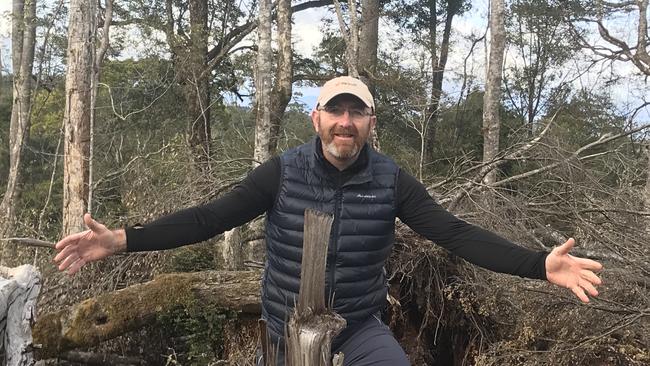
One kilometre away from the coupe is Mr Smith’s lease. He puts 36 hives there each summer and makes about 100kg of honey per hive per year.
His bees have a three kilometres fly zone.
“This lease had the potential to be a 50 hive site and I wanted to increase my operation and become a full-time beekeeper,” Mr Smith said.
“There are no new areas to access leatherwoods. There used to be 4000 commercial hives north of the Arthur River. Now there would be about 100.
“Soon there could be no leatherwood left in this area and my business will be taken away from me,”
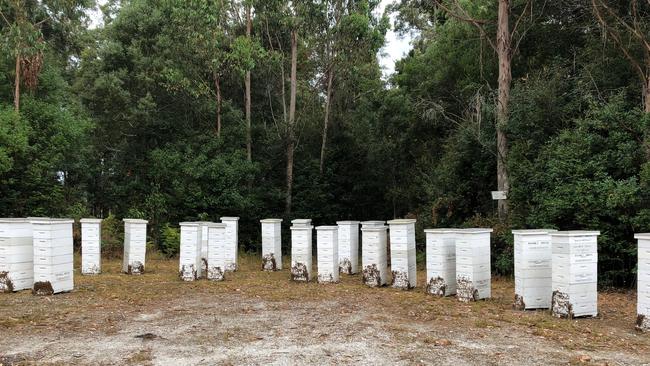
Tasmanian Bee Keeper Association president Lindsay Bourke disagreed with Mr Smith’s concerns saying the MOU with Sustainable Timbers Tasmania was working,
“Harvesting is stopped when the forest reaches the definition of commercial leatherwood,” Mr Bourke said.
“We have a harvesting plan with STT and can talk to them about the logging of certain areas. We have been working very hard with STT over the past few years and we came up with a solution to satisfy everybody
“We are saving more leatherwood than has ever been saved.”
But he said there was not enough leatherwood resource left to go into the future and beekeepers would need to access World Heritage forests at some stage to remain viable.
Under the Memorandum of Understanding between STT and the TBA - signed in 2009 - the definition of a coupe capable of contributing to supporting a viable hive site is one where there is more than 0.5ha of leatherwood and there are leatherwood stems within 20m of three others or where leatherwood trees comprise at least 25 per cent of the forest canopy.
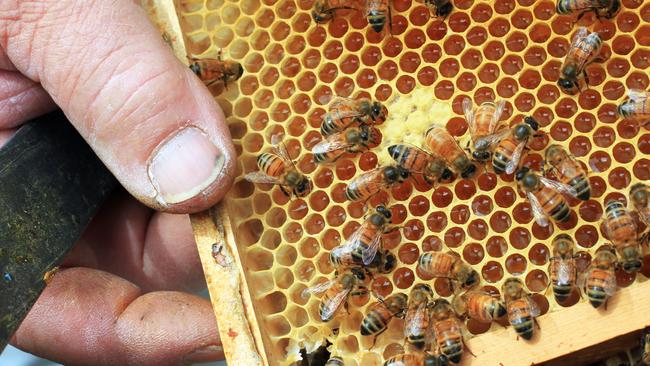
The protection of leatherwood trees has also become part of the Bob Brown Foundation’s campaign to stop the construction of a mine tailings dam in the rainforest near Rosebery.
On Thursday, the Tasmanian Crop Pollination Association joined Australian Greens Senator Janet Rice and Bob Brown Foundation in takayna/Tarkine to protest the loss of leatherwood rich rainforest to logging in association with the proposed construction of a tailing dam on MMG’s mining lease at Rosebery.
“Leatherwood honey accounts for 70 per cent of industry income in Tasmania,” said John Seirnicki, Vice President Tasmanian Crop Pollinators Association said.
“Loss of leatherwood trees will mean added running costs to help hives recover from pollinating crops. With the growing amount of new irrigated farmland we are finding it hard to keep up with demand for pollinating hives.
“Destruction of old growth rainforest will greatly restrict the growth and the future of new and younger people coming into the industry as the profit from pollination from pollination only will make beekeeping unviable”.
Sustainable Timber Tasmania Conservation and Land Maanagement general manager Suzette Weeding said her organisation was one of several Tasmanian land managers that provided
shared access and provisions for apiary production.
“STT recognises the contribution of the apiary industry to the Tasmanian regional economy and actively works alongside individual beekeepers and the Tasmanian Beekeepers Association to foster the successful coexistence of commercial leatherwood resource and wood production,” she said.
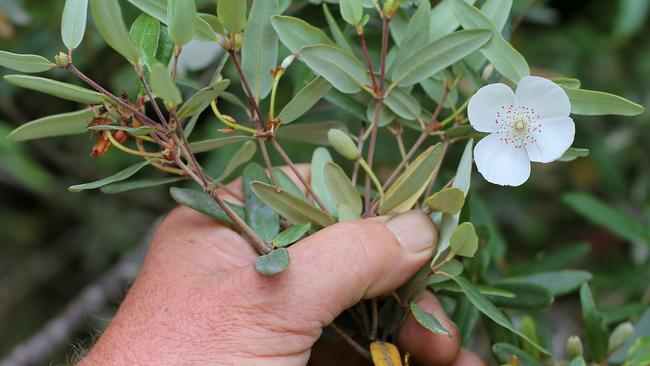
She said the MOU included an acknowledgment that both STT and beekeepers had to work together and that compromise would be required from time to time.
Across Tasmania, STT provides apiary licenses to 70 beekeepers for 304 apiary sites consisting of a total 9889 hives.
Hive sites are dispersed in the landscape, affording each site around 2800 hectares for bees to forage for nectar resources.
“TT recognises commercial leatherwood as a value that needs active management when conducting planning, harvesting and regeneration operations,” Ms Weeding said.
She said the Planning Guidelines for Apiary Values guided planners in the management of
apiary values across Tasmania’s production forest landscapes and work to minimise
any potential negative impact upon commercial leatherwood resource.
In practice, as a consequence of applying the agreed guidelines, areas of commercial
leatherwood are excluded from harvesting operations.
“In one case, Sustainable Timber Tasmania excluded almost two thirds of an entire
coupe in the North West from harvesting operations to protect the identified commercial leatherwood resource. A total of 60ha of the 93ha coupe was set aside.”
She said STT was is currently working with local beekeepers and the Tasmanian
Beekeepers Association in the North West to further enhance considerations and
management of apiary values, including leatherwood regeneration monitoring. Leatherwood
seedlings have been grown from cuttings and will be planted to further support the
monitoring project and complement naturally regenerating leatherwood.
Activists in court over World Environment Day protest
THREE of the eight Extinction Rebellion protesters who appeared in the Launceston Magistrates Court on Wednesday had convictions recorded due to similar prior offending, the rest avoiding a conviction.
Freya Maria Elizabeth Cooper, 18, Helen Elizabeth Hutchinson, 79, Rosalind Mary Lewis, 74, Graham Osborne Palmer, 74, Stephen William Saunders, 66, Gwenyth Enid Woods 71, Rohan Thomas Shapcott, 19, appeared in court together.
Magistrate Simon Brown said it would economise on the court’s time due to overwhelming similarities in the facts.
The group was arrested and charged with failing to comply with a direction of a police officer at a World Environment Day protest on June 5.
They took part in an organised demonstration on St Johns St in central Launceston with a permit for the protest issued for between 12pm and 1pm.
Following that time they were asked to move on by police twice and all refused, remaining on the roadway.
They were arrested and taken to police headquarters, before being charged and released on bail.
All eight of the protesters pleaded guilty in court on Wednesday and spoke of their need to act due to inaction on climate policy.
During the sentencing of each of them Magistrate Brown said they were of good character and were motivated by concern about the “climate crisis” which was different to the anti-social behaviour usually associated with the offence.
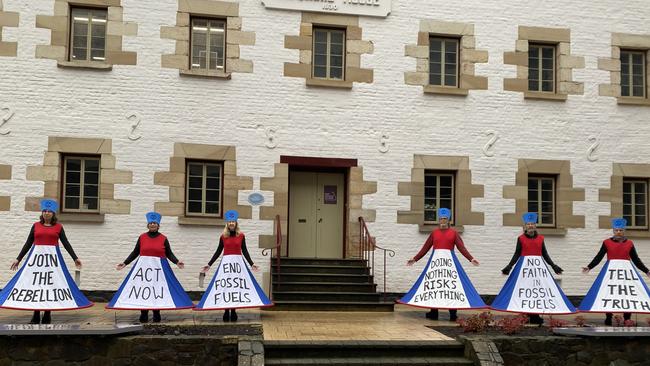
Cooper’s matter was adjourned for six months on the condition she committed to an undertaking of good behaviour for that period.
Hutchinson and Palmer had convictions recorded due prior offending.
Anthony Scott Bell, 71, appeared separately earlier in the morning.
During the sentencing of Bell, Magistrate Brown said he had “something of a history of this type offending” and without the prior offending may have proceeded without conviction.
He was fined $100 and a conviction was recorded.
All eight protesters were ordered to pay court costs of $69.30.
Ahead of the court appearance the group and some supporters gathered at Civic Square near the Launceston Magistrate Court with banners.
Several of them dressed as sibyls, female prophets in Greek mythology.
Outside court Lewis, a retired teacher and Tasmanian Honour Roll of Women inductee, said she was compelled to take action to further their cause.
“It’s my number one priority because I’m aware that it’s like a cross generational crime that we are going to leave the next generation with our mess to clean up, it’s not going to be easy, it is going to be painful, but there are positive ways we can deal with it,” she said.


